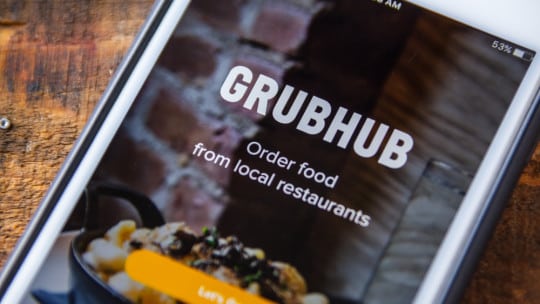
We hear about pivoting fairly regularly in Washington, D.C., usually when things aren’t going so well. That’s hardly the case with Grubhub, which offers users the ability to get meals delivered from 55,000 restaurants; the brand also gives customers the option of ordering food and picking it up at a restaurant. Last week a Morgan Stanley analyst upgraded Grubhub shares to overweight (yes, that’s an ironic use of language) due to the brand’s having gobbled up a three-course meal of competitors recently.
A Mix of Data and Trends
Yet pivoting also can be done intentionally, from a position of strength. This is critical to Grubhub’s social media content strategy, senior social media manager Mallorie Rosenbluth tells us. While Grubhub is “a data-driven company…[and] we’re constantly looking at data telling us what dishes people are ordering,” she insists on being flexible enough to cover “what’s going on in the world.”

Senior Manager, Social Media, Grubhub/Seamless
Her modest editorial team meets weekly to discuss trends “outside our four walls that we can get ahead of.” So while a recent Instagram post featuring delicious-looking avocado toast was created “because our data showed that dish trending,” a series about fried eggs was made to order. “We knew that around the country it was sweltering…so we created a blog post around the theme, ‘It’s so hot you could fry an egg on the sidewalk.’…Our take was that we could do a roundup of the eight best fried egg dishes from Grubhub that can be enjoyed in the comfort of air conditioning.”
A variant on the above is when data goes against intuition. “Everyone’s going to order wings [for the Super Bowl], right? We looked at the data and it showed Indian food was trending.” That data informs future content creation, she says.
This formal and informal mix explains Grubhub’s social content strategy. It’s an eclectic pastiche of data-driven content on the usual platforms, such as Instagram, Facebook and Twitter, as well as email and The Crave blog. Grubhub uses an editorial calendar to “plan content for particular days,” yet there’s room for content created more quickly from trends, such as the fried egg example above. Rosenbluth takes pride in the speed her team can turn around a trend-based piece of content. “We can do it in hours or days.”
Content Pillars and Leaning In
The formal portion of Grubhub’s content comes from planning meetings. About eight weeks in advance of a campaign the team creates “content pillars,” Rosenbluth says. “They’re the categories of content that we want to address…the focus areas…the lean-in points.”
As opposed to trying to change behavior, Grubhub is more interested in enhancing consumers’ normal behavior. For its recent Summerlicious campaign, the thinking was summers are busy times. “People are running around…dropping kids off at camp…soccer games…taking trips…and delivery of [food] is one of the last things they think of…many people just grab [whatever food] is in front of them. So we try to get them to consider ordering [from Grubhub] as they run from place to place…to enhance their life,” she says.
Still, she won’t let these pillars snuff out spontaneity. “I like to call them the places we get to play in.”
The brand’s thinking on storytelling always starts with goals. “Not every piece of content is designed to drive a conversion. Some are designed to bring people into the funnel or to raise brand awareness,” she says. “From there we develop extensions of a basic story, or concept, that work for each channel and the multiple goals of a campaign.” [See sidebar below]
Storytelling: Start with Engagement, Business Goals Come Later
For storytelling, Rosenbluth advocates “taking off your marketing hat and just understanding people as people, not just as business prospects.” This ensures brands tell stories that are engaging. “We then create iterations and executions that will achieve our business goals. We don’t create for the business goal and then back the story into it. That never works.”
- Understand the challenge you’re trying to overcome
- Take a consumer insight: Get inside the mind of the audience, understand the motivations and lean into its existing behaviors
- Develop the message—or story—that brings to life how you’re leaning into the behaviors
- Outline the metrics of success and channels available to tell the story
- Iterate off the initial story so the executions are optimized for channel and desired result
